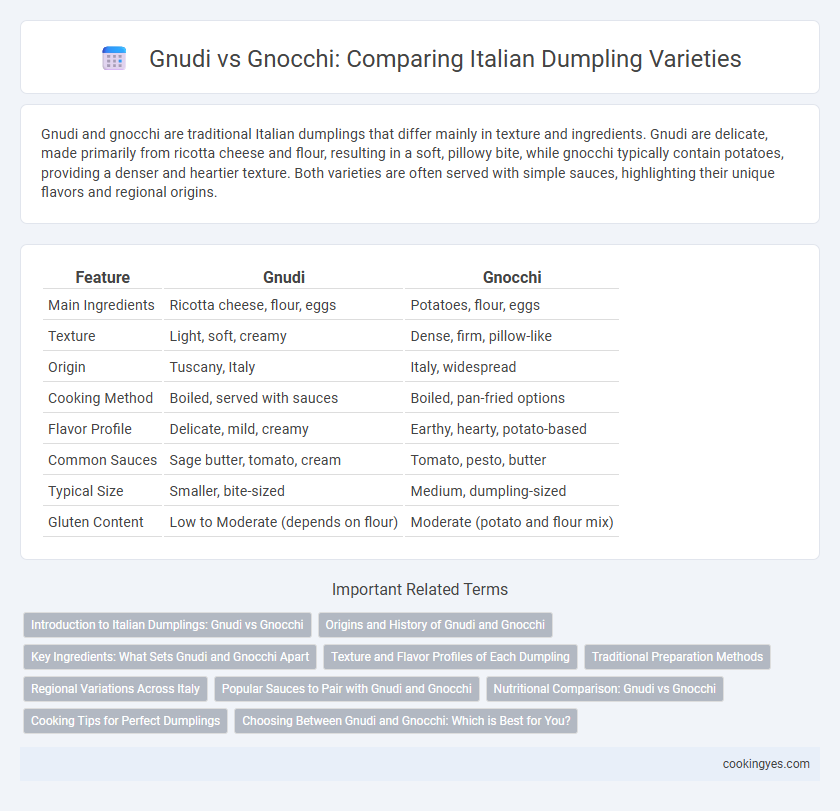Gnudi and gnocchi are traditional Italian dumplings that differ mainly in texture and ingredients. Gnudi are delicate, made primarily from ricotta cheese and flour, resulting in a soft, pillowy bite, while gnocchi typically contain potatoes, providing a denser and heartier texture. Both varieties are often served with simple sauces, highlighting their unique flavors and regional origins.
Table of Comparison
| Feature | Gnudi | Gnocchi |
|---|---|---|
| Main Ingredients | Ricotta cheese, flour, eggs | Potatoes, flour, eggs |
| Texture | Light, soft, creamy | Dense, firm, pillow-like |
| Origin | Tuscany, Italy | Italy, widespread |
| Cooking Method | Boiled, served with sauces | Boiled, pan-fried options |
| Flavor Profile | Delicate, mild, creamy | Earthy, hearty, potato-based |
| Common Sauces | Sage butter, tomato, cream | Tomato, pesto, butter |
| Typical Size | Smaller, bite-sized | Medium, dumpling-sized |
| Gluten Content | Low to Moderate (depends on flour) | Moderate (potato and flour mix) |
Introduction to Italian Dumplings: Gnudi vs Gnocchi
Gnudi and gnocchi are traditional Italian dumplings originating from Tuscany and various regions across Italy, respectively, with gnocchi commonly made from potatoes, flour, and eggs, while gnudi are primarily crafted from ricotta cheese and spinach, offering a lighter texture. The subtle flavor of gnudi highlights the freshness of ricotta and greens, contrasting with the denser, earthier taste of potato-based gnocchi. These dumplings showcase regional culinary variations and exemplify the diversity within Italian pasta traditions.
Origins and History of Gnudi and Gnocchi
Gnudi, originating from Tuscany, are light Italian dumplings made primarily with ricotta cheese and flour, contrasting with traditional Gnocchi which trace back to Roman times and are primarily crafted from potatoes and flour. The name "Gnudi" means "naked" in Italian, referring to the absence of leaves that typically wrap ravioli, highlighting their unique, ricotta-centered composition rooted in Tuscan culinary tradition. Gnocchi's history spans centuries across Italy, evolving from ancient Roman dishes using semolina and herbs to modern variations emphasizing potato as the key ingredient, reflecting a diverse regional heritage.
Key Ingredients: What Sets Gnudi and Gnocchi Apart
Gnudi and gnocchi differ primarily in their key ingredients, which shape their texture and flavor profiles. Gnudi are made chiefly from ricotta cheese and flour, creating a light, delicate dumpling without potato, while traditional gnocchi rely on mashed potatoes combined with flour for a denser, heartier bite. The use of ricotta in gnudi results in a tender, pillowy texture, contrasting with the firmer, more robust consistency of potato-based gnocchi.
Texture and Flavor Profiles of Each Dumpling
Gnudi dumplings are traditionally made from ricotta cheese and spinach, lending a light, pillowy texture and a delicate, creamy flavor that highlights the freshness of the dairy. Gnocchi, typically made from potatoes and flour, offer a denser, chewier bite with a mild, earthy taste that serves as a versatile base for various sauces. The contrasting textures--soft and airy gnudi versus hearty and substantial gnocchi--define their unique roles in Italian cuisine.
Traditional Preparation Methods
Gnudi and gnocchi both stem from traditional Italian dumpling recipes, yet they differ significantly in preparation methods. Gnudi are made primarily from ricotta cheese mixed with flour and sometimes spinach, resulting in a lighter, softer texture without the use of potatoes. Gnocchi, traditionally crafted from cooked potatoes, flour, and eggs, require boiling and often pan-searing to achieve a denser and chewier consistency that holds up well with various sauces.
Regional Variations Across Italy
Gnudi and gnocchi are distinct Italian dumpling varieties with strong regional roots, particularly in Tuscany and Northern Italy respectively. Gnudi, often made from ricotta and spinach, showcase the light, fluffy texture associated with Tuscan cooking, while gnocchi, typically potato-based, reflect the hearty, rustic flavors favored in Northern Italian cuisine. These variations highlight the diversity of Italy's culinary traditions, with gnocchi prevalent in regions like Piedmont and Lombardy, and gnudi more commonly found in Central Italy's Tuscan kitchens.
Popular Sauces to Pair with Gnudi and Gnocchi
Gnudi, delicate Italian dumplings made primarily from ricotta cheese and spinach, pair exceptionally well with light sauces like sage butter and simple tomato basil, which highlight their creamy texture without overpowering their subtle flavor. Gnocchi, denser potato-based dumplings, complement rich sauces such as Bolognese, pesto, and hearty gorgonzola cream that enhance their robust, pillowy consistency. Both varieties benefit from a drizzle of Parmesan cheese to add depth, making sauce choice crucial in balancing the dumplings' unique textures and tastes.
Nutritional Comparison: Gnudi vs Gnocchi
Gnudi, made primarily from ricotta cheese and spinach, typically contain higher protein and calcium levels compared to gnocchi, which are primarily potato-based and offer more carbohydrates. Gnocchi provide a greater energy source due to their higher carbohydrate content, while gnudi are lower in calories and fat, making them a lighter option. Both variations contribute unique nutrients, with gnocchi offering more fiber when prepared with whole wheat flour, and gnudi delivering antioxidants from spinach.
Cooking Tips for Perfect Dumplings
Gnudi and gnocchi differ in texture and ingredients, with gnudi made primarily from ricotta cheese and gnocchi from potatoes, affecting cooking times and techniques. To achieve perfect dumplings, boil them gently in salted water until they float, ensuring a delicate texture without breaking apart. Lightly dusting gnudi with flour before boiling prevents sticking, while adding a touch of butter post-cooking enhances their creamy mouthfeel.
Choosing Between Gnudi and Gnocchi: Which is Best for You?
Gnudi and gnocchi both showcase traditional Italian dumpling varieties but differ in texture and ingredients, influencing your choice based on culinary preference. Gnudi, made primarily from ricotta cheese and spinach, offer a lighter, fluffier bite ideal for those seeking a delicate experience. Gnocchi, crafted from potato and flour, provide a denser, hearty texture better suited for rich sauces and substantial meals.
Gnudi vs Gnocchi for Italian dumpling varieties Infographic

 cookingyes.com
cookingyes.com